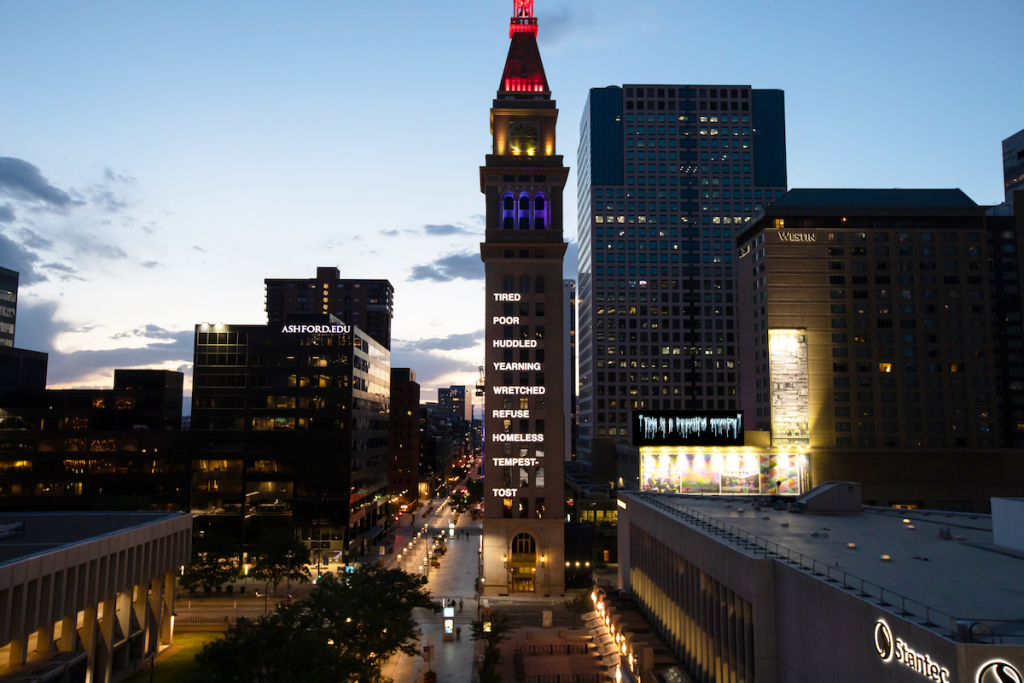[ad_1]
For the next two months, the words “tired,” “poor,” “huddled,” “yearning,” “wretched,” “refuse,” “homeless,” and “tempest-tost” will appear on the facade of one of Denver’s most iconic landmarks, a narrow clocktower. Visible via a multi-story projection on the city’s Daniels and Fisher Clocktower, they form artist Nari Ward’s latest artwork, a vertically-oriented video titled LAZARUS Beacon and presented in conjunction with the artist’s ongoing retrospective, “We the People,” at the Museum of Contemporary Art Denver.
When curator Diana Nawi first approached Ward about creating a public exhibition to coincide with the museum show, the artist had an idea that would fit seamlessly with the city’s architecture—and one that would also look at the history of the United States, which is frequently the focus of much of Ward’s work. Ward based LAZARUS Beacon, which itself is based on a piece made of hundreds of shoelaces called LAZARUS that figures in the MCA Denver exhibition, on the 19th-century poet and activist Emma Lazarus’s famed 1883 sonnet The New Colossus, which appears on a plaque atop the pedestal of the Statue of Liberty. In Ward’s hands, the words from the poem appear in succession between the windows of the slim tower.
Ward told ARTnews that the two works consider “what America is, what it represents, and how it was framed for generations of Americans” and that they are “pushing back against the current administration’s anti-immigration zeal, which is an anti-American agenda in a way, too.”
Organized in collaboration between the MCA Denver and Orange Barrel Media, Ward’s public exhibition, on view through September 20, also features black-and-white and color images of Ward’s wall-drawings, which he creates by drilling shoelaces into walls, on digital billboards and kiosks throughout downtown Denver. Many of the text-based works that have been reoriented for public view focus on protest and social justice, with two pieces bearing the lyrics “We Shall Overcome” and “Blowin’ in the Wind.”
“Pretty much all of the texts that I was working with—not just for LAZARUS Beacon but for the illuminated billboards—are coming from Civil Rights-era language, and the idea that we’re in another moment of change really worked and meant something,” Ward said.

Photo by Orange Barrel Media/Courtesy the artist; Lehmann Maupin, New York, Hong Kong, and Seoul; and Galleria Continua, San Gimignano, Beijing, Les Moulins, Habana, and Roma
Ward sees the public exhibition as an opportunity to introduce audiences to his work and hopefully pique their interest in it. He said that his wall-drawings have taken on a different valence now that they’re on billboards. When experienced in person, there’s a certain “obscuring and illegibility” to those works depending on viewers’ physical position in relation to them. On the billboards, they’re more easily and immediately read, but Ward said that there’s a new, abstracted quality to them in that format that he hadn’t anticipated.
“There’s a strange silver lining to this pandemic in terms of people having to deal with things that normally they may not confront head on,” Ward said of the issues his works take up. “I like to think of these [billboards] kind of just coming up. People expect to see promotions for watches or events, and they’ll see this sign come up and I feel like that chance encounter is really special.”
[ad_2]
Source link
Warning: Undefined variable $post in /var/www/wp-content/themes/newsup/inc/ansar/hooks/hook-index-main.php on line 117

